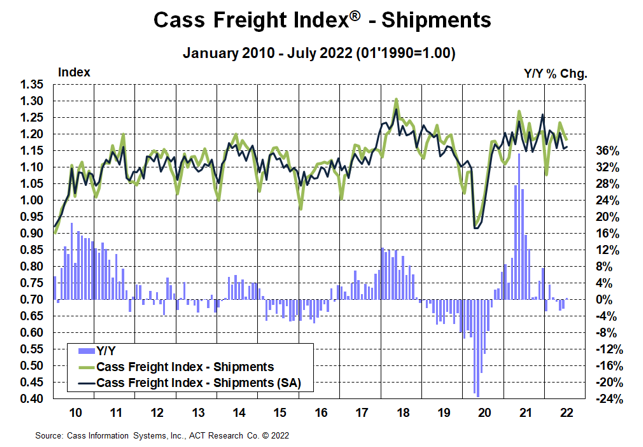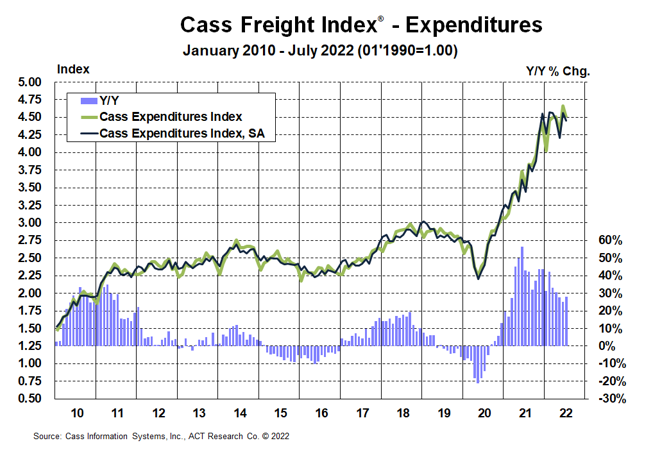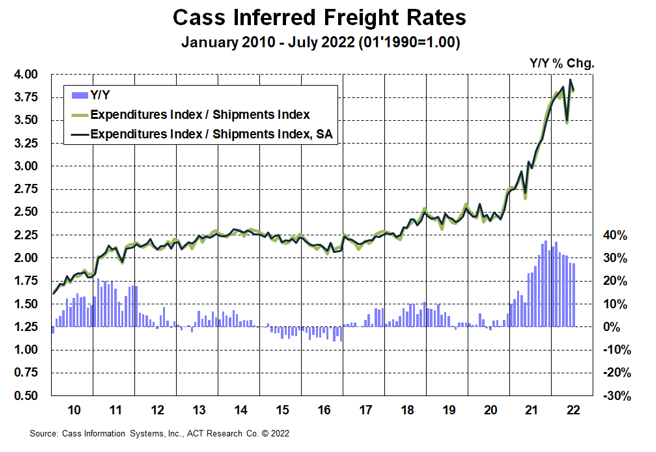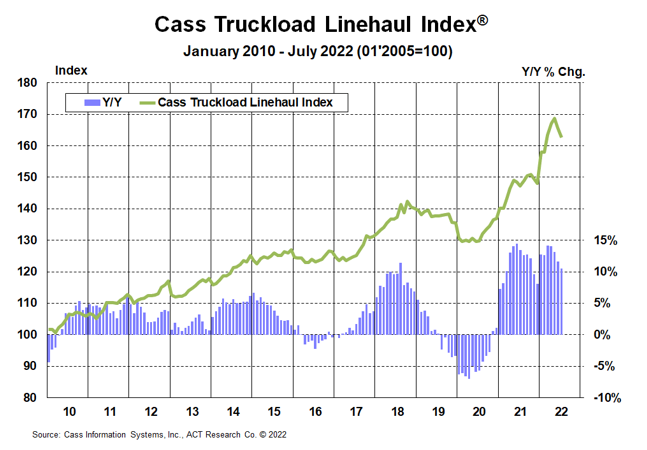Get the most up-to-date data and insights into shipping volumes and the cost of freight. See how they change each month and understand the market forces behind them.
| July 2022 | Year-over-year change | 2-year stacked change | Month-to-month change | Month-to-month change (SA) | |
| Cass Freight Index - Shipments | 1.182 | 0.4% | 16.1% | -1.7% | 0.6% |
| Cass Freight Index - Expenditures | 4.499 | 28.2% | 83.5% | -3.6% | -2.4% |
| Cass Inferred Freight Rates | 3.806 | 27.6% | NA | -1.8% | -2.9% |
| Truckload Linehaul Index | 162.7 | 10.5% | 25.3% | -1.8% | -- |
The shipments component of the Cass Freight Index® rose 0.4% on a y/y basis in July, after a 2.3% decline in June and in line with expectations.
Normal seasonality from this index level would imply shipments down slightly y/y in Q3 and down 4%-5% y/y in Q4.

See the methodology for the Cass Freight Index.
The expenditures component of the Cass Freight Index®, which measures the total amount spent on freight, fell 3.6% m/m in July from the record level in June, evenly split with shipments down 1.7% and rates down 1.8%.
We estimate roughly 8pps-10pps of the y/y increase is currently due to fuel prices alone, and part of the m/m decline in rates was due to lower fuel prices. This index includes changes in fuel, modal mix, intramodal mix, and accessorial charges.
Simply following normal seasonality from here, this index is on track for a 23% increase and would turn down on a y/y basis in December.

The freight rates embedded in the two components of the Cass Freight Index® still rose 28% y/y in July, a slight deceleration from June.
With the tight supply/demand balance in U.S. trucking markets easing considerably this year, industry rates are topping out and set to slow sharply in the months to come. Based on the weekly trends, fuel should provide additional relief in August as well. Diesel prices continue to reflect elevated refining margins, and could fall further, but could also easily revert higher if the situation in Europe worsens.
While shippers aren’t seeing any real savings yet, such relief is now highly probable, which is welcome news for the broader inflation picture.

Cass Inferred Freight Rates are a simple calculation of the Cass Freight Index data, expenditures divided by shipments, producing a data set that explains the overall movement in cost per shipment. The data set is diversified among all modes, with truckload representing more than half of the dollars, followed by LTL, rail, parcel, and so on.
The The Cass Truckload Linehaul Index® rose 10.5% y/y in July to 162.7 after rising 11.6% y/y in June.

See the methodology for the Cass Truckload Linehaul Index.
One of the most interesting observations about truckload spot rates this year is the symmetry of the decline of about 75c-80c/mile, ex-fuel, which is exactly the amount they jumped after the initial market tightening in 2H'20. Spot rates have rebounded a bit in recent weeks, ex-fuel, with at least some temporary relief from the significant drop in diesel prices.
This brings to mind some of our favorite axioms, like “the laws of supply and demand have yet to be repealed” and “the cure for high prices is high prices.”
Now that the pendulum is swinging, “how bad?” and “how long?” have become some of the most crucial questions about the freight rate cycle. The ACT Freight Forecast report provides monthly, quarterly, and annual predictions for the truckload (TL), LTL, and intermodal markets, including capacity, volumes, and rates. The report provides monthly updates of forecasts for the shipments component of the Cass Freight Index® and the Cass Truckload Linehaul Index® through 2024, as well as DAT spot rates by trailer type, including and excluding fuel surcharges.
Release date: We strive to release our indexes on the 12th of each month. When this falls on a Friday or weekend, our goal is to publish on the next business day.

Tim Denoyer joined ACT Research in 2017, after spending fifteen years in equity research focused primarily on the transportation, machinery, and automotive industries. Tim is a senior analyst leading ACT’s team transportation research effort, and the primary author of the ACT Freight Forecast, U.S. Rate and Volume Outlook. Research associate Carter Vieth, who joined ACT in early 2020 after graduating from Indiana University, also contributes to the report. This report provides supply chain professionals with better visibility on the future of pricing and volume in trucking, the core of the $1.06 trillion U.S. freight transportation industry, including truckload, less-than-truckload, and intermodal.
Tim also plays roles in ACT Research’s core Class 4-8 commercial vehicle data analysis and forecasting, in powertrain development, such as electrification analysis, and in used truck valuation and forecasting. Tim has supported or led numerous project-based market studies on behalf of clients in his four years with ACT Research on topics ranging from upcoming emissions and environmental regulations to alternative powertrain cost analyses to e-commerce and last-mile logistics to autonomous freight market sizing.
ACT’s freight research service leverages ACT’s expertise in the supply side economics of transportation and draws upon Tim’s background as an investment analyst, beginning at Prudential and Bear Stearns. Tim was a co-founder of Wolfe Research, one of the leading equity research firms in the investment industry. While with Wolfe, Tim was recognized in Institutional Investor’s survey of investors as a Rising Star analyst in both the machinery and auto sectors. His experience also includes responsibility for covering the industrial sector of the global equity markets, including with leading investment management company Balyasny Asset Management.
The material contained herein is intended as general industry commentary. The Cass Freight Index, Cass Truckload Linehaul Index (“Indexes”), and other content are based upon information that we consider reliable, but Cass does not guarantee the accuracy, timeliness, reliability, continued availability or completeness of any information or underlying assumptions, and Cass shall have no liability for any errors, omissions or interruptions. Any data on past performance contained in the Indexes is no guarantee as to future performance. The Indexes and other content are not intended to predict actual results, and no assurances are given with respect thereto. Cass makes no warranty, express or implied. Opinions expressed herein as to the Indexes are those of Stifel and may differ from those of Cass Information Systems Inc. All opinions and estimates are given as of the date hereof and are subject to change.
© Copyright 2023 Cass Information Systems, Inc.